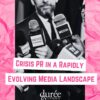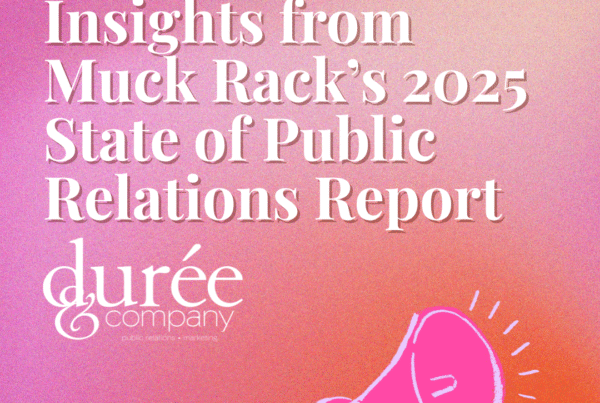
According to the U.S. Census, public relations jobs exceed reporter jobs by more than six to one. With six publicists to every reporter, it’s even more important that your pitch is perfect as journalists’ inboxes are being bombarded daily.
Public Relations is used to persuade an audience or tell a story by using unpaid or earned techniques. Promotion is conducted through a trusted, organic, third-party source – also known as earned media. Earned media requires developing a strategic plan from start to finish – from creating a story angle, constructing a relevant media list, pitching the story and following up to attain coverage. It is very important to build rapport with journalists and pitch them correctly so that the chances of gaining coverage for your client increases.
At Aspen and Fort Lauderdale-based public relations agency Durée & Company, we take pride in the perfect pitch and our strong relationships with journalists. We have over 20 years of experience in strategizing and executing newsworthy pitches for diverse clients in multiple industries – from Miami to Aspen and everywhere in between.
For maximum pitching success, here are some tips from journalists that you won’t learn in Public Relations 101:
- Send relevant pitches to the appropriate contacts and spell their name correctly – Journalists receive hundreds of e-mails a day and are more apt to work with publicists when they send pitches that are relevant. When pitching, it’s important to research and identify the appropriate contacts at publications that are appropriate for your client’s audience. “There’s so much you can tell with just a cursory quick scan of the website,” said Sun Sentinel entertainment reporter Rod Hagwood. By looking at the media outlet’s website you can tell who should get the pitch and if the topic has already been covered. Don’t forget to triple check that you are spelling the journalist’s name right!
- Keep it concise – When writing your subject line, keep it enticing but simple. Journalists inboxes are flooded with pitches every day so your entire subject line should be able to be viewed at one glance so that journalists have a sense of what your pitch is about before they even open the e-mail. “Keep pitches short and sweet. Believe it or not, I am most interested in the subject line of your e-mail pitch — so make it snazzy and catchy,” said Miami-based influencer Maria Tettamanti of The Wordy Girl.
- Ensure that your pitch has everything a journalist needs to craft a story – When pitching a story idea, make sure that the pitch has everything the reporter needs to craft their story. The pitch should include the who, what, when, where, why and how; a working link to photos and proper photo credit; and links to the brand’s website and social media. Also offer up a key spokesperson from the brand that the reporter can interview. “While mistakes happen on both the PR and publication sides, we all need to take the extra time to proofread and fact check our correspondence, and to ensure we are being as efficient and considerate as possible with our communication tactics. Both professionalism and due diligence go a long way,” said Tracy Block, Founder and President of Block Media Worldwide.
- Don’t ask for questions in advance of an interview – Every publicist wants to have as much assurance as possible that an interview will go well and that their client is prepared. Most times, journalists will not provide questions and it is a rarity if they do. If a client does not want to speak about a certain subject during an interview, they can choose not to comment, and the journalist will respect that.
- Keep deadlines top of mind – In the rapidly changing media industry, communication is key when working on a story with a journalist. They are pressured to constantly deliver new content and are often times working on numerous stories simultaneously. Ensure that you have all materials requested by the journalist prior to the deadline so that they don’t have to follow up with you and they can get their story in on time.
- Don’t ask to see a story before it’s published – It is a huge faux pas for most outlets to share story proofs or drafts prior to the article’s publication, so it’s best not to ask a journalist to see their story. In most cases, journalists or editors will fact check the article and ask if they have any questions. It also signals to the journalist that you do not trust them and they may be less inclined to work with you in the future.
- Messaging influencers on social media is a no-no – There are many benefits to working with influencers. Influencer marketing is continuing to rise with brands’ budgets for influencer marketing growing in double and triple digits according to an article published on Forbes. It is important to respect influencers’ privacy and not direct message them through social media. “DMs are NOT the new e-mail,” said Tettamanti. Before reaching out to an influencer, first, identify that they are the appropriate influencer for your campaign and that they can convey the right message to your target demographic. Then determine how you would like them to promote your brand and what your budget is for that campaign. Once the parameters are established, begin the conversation via e-mail.
- Tread lightly when asking for a modification – If a story has a factual error after it’s been published, be polite and gracious when asking for any edits. Politely point out the inaccuracy and give the reporter the correct information.
Remember to always be appreciative when communicating with a journalist, producer or blogger. Many journalists today are writing stories for different publications or may even be working as a journalist in addition to a full-time job. Also, promoting the published story on social media and tagging the journalist is a great way to show your appreciation and ensure that they remember you for the next story they’re working on. “When you work with great PR people, it really makes you appreciate it when you work with NOT so great PR people,” said Christiana Lilly, the managing editor of Luxe Interiors + Design Magazine.
Do you need help effectively getting your brand beyond a journalists’ inbox? Check out our Dynamo Diary or Instagram for more insight and #behindthescenes on #PRlife!








